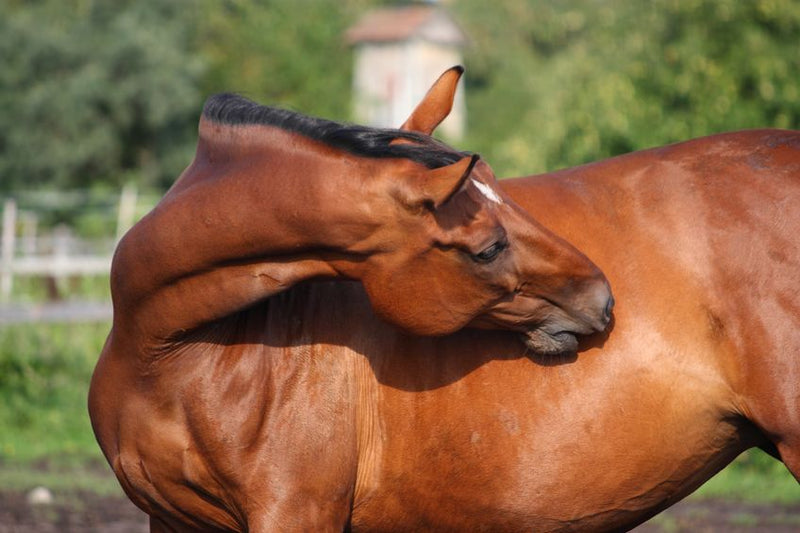Key Takeaways:
- Causes of horse abdominal pain range from intestinal twists to blockages to infections.
- The equine GI tract is large and complex and suspended within the abdomen from single attachment points to the body wall, allowing certain parts to move around and potentially twist or displace.
- Colic can be obstructive or nonobstructive, gastrointestinal or non-gastrointestinal.
- Understanding the root cause of equine colic will help your veterinarian make potentially life-saving treatment and management decisions.
The classic signs of colic, from flank-watching to rolling, are fairly universal. The cause of that abdominal pain, however, can range from twists to blockages to infections. And depending on a colic’s cause, treatment steps and prognoses can vary widely. So let’s try to understand what could cause discomfort inside the cavernous equine abdomen.
Horse Gastrointestinal Anatomy: A Brief Review
The equine GI tract is large and complex. Food first passes through the 2.5-gallon stomach, winds through the small intestine—which, at about 70 feet, is one of the longest organs in the horse’s body—gets broken down in the cecum, digests in the large colon/intestine, and finally passes through the small colon as manure.
Much of the horse GI tract is suspended within the abdomen from single attachment points at the body wall, allowing certain parts to move around and potentially twist or displace.
“It’s amazing how much of the 120 to 130 feet of intestine can be physically lifted out of the horse’s abdominal cavity during surgery,” says Dr. Keith Latson, an equine surgeon and co-founder and director of operations at FullBucket, a veterinary-strength supplement business based in Weatherford, Texas. “We can remove almost the entirety of the large intestine from the abdomen, almost the full 15 feet of small colon. Most of the small intestine we can pull out like a single strand of spaghetti that we can literally run through our hands from end to end, and that’s something that we do routinely during colic surgery.”
Depending on where and how they occur, causes of colic can be obstructive or nonobstructive.
Obstructive Colic
Obstructive colic happens when anything blocks digestive material from passing through the horse’s digestive tract. Food, for instance, can lodge and harden within the intestine, creating an impaction. Or a section of intestine can twist to the point that nothing can get through.
“In a horse that’s problematic, because they’re eating so much and they’re drinking so much that everything in front of that obstruction starts to get bigger, it just fills up,” says Latson. “And for anybody who has had gas in their lifetime, they know how painful it is when that intestine stretches because of the gas. This is what happens when you have an obstructive colic, and this is a horse that throws itself down violently, because that intestine is starting to stretch and the pain receptors are going, ‘Oh my gosh, this is killing me,’ and in some cases it literally is.”
Parasites, enteroliths (intestinal stones), and sand buildup can partially or fully obstruct the horse digestive tract, as well.
“In some cases horses live with enteroliths for a long time because they’re not big enough or they’re not jammed far enough down in the intestine to stop feed or gas from moving past them,” Latson says. “So they don’t necessarily create a problem that we can see. It’s a problem that’s brewing, but it’s not one that we can see until it creates a more severe (and painful) blockage.”
Twists, or strangulating colics, almost always require surgery, while many blockages resolve with medical therapy such as fluids and supportive care.
Nonobstructive Colic
Colics that don’t fall under the obstruction category are nonobstructive. These include pain from gastric ulcers, inflammatory conditions such as colitis and enteritis, microbes such as Salmonella, toxins such as those released by blister beetles, and more. Basically, if the large colon gets irritated, cramps, or spasms, it’s going to manifest as colic.
“These are the ones where we start seeing some of the chronic low-grade colic,” says Latson. “Maybe you see a little bit of pain if you get some horse feed accumulation behind it, and then it passes through.”
Often, nonobstructive colics such as those caused by colitis and Salmonella are associated with mild to explosive diarrhea. In fact, mild clinical signs of colic might be your first indication—before the horse develops diarrhea—that something’s not right and the equine digestive system isn’t operating as it should.
Nonobstructive colics can also stem from pain that’s not even in the GI tract.
“I think this is a really tough one for some people to understand, because the immediate knee-jerk response to colic in a horse is, ‘It’s the intestines,’ ” says Latson. “But it could be the kidneys, it could be something in the liver, it could be the ovaries, reproductive tract, bladder stones. All of these things may manifest in the horse as pain symptoms and signs that appear to be colic.”
Take-Home Message
Think of colic in the horse as either obstructive or nonobstructive—that’s what veterinarians do when making treatment decisions.
“When we’re examining a horse, we ask ourselves, ‘Does this look potentially obstructive, could this be a nonobstructive cause, or could this be a non-GI cause of colic?’ ” says Latson.
Vets approach strangulating obstructions in a horse as surgical emergencies and treat most nonstrangulating and nonobstructive cases medically, using fluids, hand-walking, pain medications, laxatives, and more. Once your veterinarian has treated the cause of your horse’s digestive distress, supplement with prebiotic and probiotic products, such as FullBucket’s Equine Probiotic Paste, to help restore the gut microbiome’s balance and keep your horse healthy going forward.
